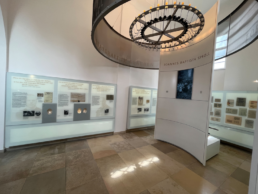"Is and remains a role model in faith"
With a ceremony on Tuesday evening, Bishop Dr Gebhard Fürst opened the memorial for Confessor Bishop Joannes Baptista Sproll.
With a ceremony on Tuesday evening, Bischof Dr. Gebhard Fürst opened a memorial for his predecessor in office, Johannes Baptista Sproll, who was the only bishop in Germany to be banned from his diocese by the National Socialists. The interest in the new memorial in the Episcopal Ordinariate was so great that the chairs provided in the foyer were not enough to seat everyone.
Bishop Sproll and his faith-based resistance to the Nazi dictatorship must not be forgotten, Fürst emphasised in his welcoming speech. In the presence of the former Minister President of Baden-Württemberg, Erwin Teufel, he recalled that in 2006, during a joint visit to the memorial for the witnesses of faith of the 20th century in Rome, one of the stones was laid. In 2006, during a joint visit to the memorial for the witnesses of the 20th century in Rome, one of the stones with which the Nazis had broken the windows of Bishop Sproll’s study in the former episcopal palace in 1938 was laid down.
Remembrance needs a place
“Remembrance needs a place, especially in Rottenburg, at the bishop’s seat. That is why the establishment of this memorial right here is very close to my heart and I am very pleased that we now have an outstanding memorial here,” Bishop Fürst stated in his address and recalled that beatification proceedings for Bishop Sproll were opened in 2011, which “hopefully will be decided positively”.
The exhibition designed by Dr Melanie Prange, director of the Diözesanmuseum, and Dr Herbert Aderbauer from the Diözesanarchiv, with the assistance of the Stuttgart office “von Jacobs. Ausstellungsgestaltung – Innenarchitektur”, invites visitors to an introduction to the work of Bishop Sproll through seven chronologically arranged thematic areas with texts, pictures and objects. In addition, the exhibition offers visitors the opportunity to learn more about Bishop Sproll through a multimedia presentation and guided tours.
Orientation and role model
“The memorial is designed for a large public: Groups can and should also come. Especially for school classes, a visit would be relevant for history and religion classes on the topic of Christian faith and resistance,” the Bishop of the Diocese of Rottenburg-Stuttgart emphasised, referring to Sproll’s attitude to topics such as racism and nationalism, which also provides orientation and a role model for the coming generation, as well as Sproll’s commitment to peace. It was of particular importance that Bishop Sproll did everything “entirely out of his Christian faith”, Bishop Fürst emphasised. “He is and remains a role model in faith.”
Besides Cardinal Count von Galen, Sproll was the only bishop who publicly and resolutely stood in the way of the National Socialists – and did so earlier than von Galen, Fürst emphasised, recalling that Sproll had been revered for decades by the population of the Diocese of Rottenburg-Stuttgart as a confessor bishop who resisted National Socialist ideology.
Outside the diocese, however, Bishop Sproll is unfortunately still too little known. “We must therefore continue to make it our task to make his attitude and his deeds generally known: The memorial is intended to contribute to this,” Bishop Fürst said, pointing out that against this background the memorial takes into account the need for remembrance, recollection and also for bringing him into the present.
A special room
Vicar General Dr. Clemens Stroppel summed it up in his invitation to visit the memorial site after the official part of the opening ceremony, which was musically accompanied by a clarinet quintet of the Rottenburg town band: The memorial site is located at the place where Bishop Sproll was taken away by the National Socialists, to which he returned after the end of the Nazi regime and the time of his exile, and at the place where he was laid out after his death before being buried in the bishop’s crypt of the Sülchenkirche.
The new memorial has thus been created on a historical site in the entrance area of the former episcopal palace. “It is the entrance hall to the bishop’s former home and thus the inside of the large wooden portal that the Nazis smashed in 1938 when they stormed the house to force Bishop Sproll to leave his diocese,” Dr Herbert Aderbauer recalled.
Dr Dominik Burkard, professor at the Julius Maximilian University of Würzburg and chairman of the History Association of the Diocese of Rottenburg-Stuttgart, went into detail in his lecture entitled “Rottenburg – Rome – Berlin. The ‘Sproll Case’ in the Focus of Diplomacy” at the opening ceremony, he explored the question of what was done on the part of the Vatican to come to Sproll’s aid. “Did they do anything at all or did they leave the bishop of Rottenburg ‘out in the cold’?” asked Burkard.
Note
The memorial is a branch of the Diocesan Museum in Rottenburg, where further information can be obtained by calling +49 7472 / 922180 and -82 or by emailing museum-sprollgedenkort@bo.drs.de.





